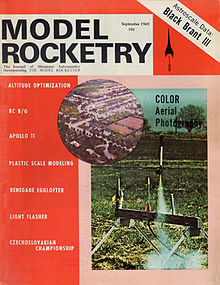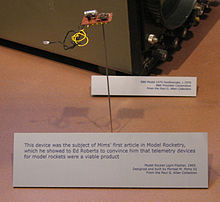- Model Rocketry (magazine)
-
Model Rocketry 
September 1969 issue of Model Rocketry.Managing Editor Gordon Mandell Categories Hobby magazines Frequency Monthly Circulation 15,000 Publisher George Flynn First issue October 1968 Final issue
— NumberFebruary 1972
Vol. 4 No. 4Company Model Rocketry, Inc. Country  United States
United StatesLanguage English Model Rocketry was an American hobbyist magazine published from October 1968 to February 1972. The Editor and Publisher was George Flynn and the Managing Editor was Gordon Mandell. The magazine was owned by the editorial staff and the paid circulation reached 15,000 by 1970.[1]
The launch of Sputnik in 1957 and the space race to the moon made model rockets a popular hobby. This magazine was started at the height of the Apollo program. Each issue had plans and instructions for constructing rockets typically powered by black powder rocket motors such as those made by Estes Industries. There were also technical articles on model rocket design that would include several pages of theory and equations. There was a series of articles starting in October 1969 on writing FORTRAN programs to calculate flight parameters. The magazine also covered model rocketry clubs' launch meets and contests.
From August 1969 to February 1972 Model Rocketry incorporated The Model Rocketeer, the official journal of the National Association of Rocketry.
The September 1969 issue of Model Rocketry has a typical cover design and contents. The cover photo shows the launch of a model rocket approximately 2 feet (60 cm) tall with a small camera as the payload. The camera will take a photo after the rocket reaches its apogee and starts its descent with a parachute. The magazine has construction plans for an egg lofting rocket. These would be used in competitions to see how high an egg could be launched without cracking. The topics on the cover include Apollo 11. There was a 6 page article by the Managing Editor, Gordon Mandell, about the first manned mission to land on the moon.
Micro Instrumentation and Telemetry Systems
In July 1969, Publisher George Flynn attended the Southwestern Model Rocket Conference at Eastern New Mexico University. There he met Air Force Captain Forrest Mims, senior advisor to the Albuquerque Model Rocket Club.[2][3] Mims told Flynn about a transistorized lamp flasher for tracking night launched rockets. He also described modulating Light Emitting Diodes to transmit data from the rocket to infrared detectors on the ground. Flynn invited Mims to write an article about his "Transistorized Tracking Light for Night Launched Model Rockets" and it was published in the September 1969 issue of Model Rocketry.[4]
Mims was stationed at Kirtland Air Force Base in Albuquerque NM with a fellow officer, Ed Roberts. They decided to form a company to sell electronic kits for projects like the tracking light. Mims, Roberts and two other coworkers formed Micro Instrumentation and Telemetry Systems (MITS) in late 1969.[5] The press release announcing the formation of MITS was published in the December 1969 issue of Model Rocketry. In January 1975 MITS introduced the Altair 8800 computer and the personal computer revolution was launched.[6] Bill Gates and Paul Allen moved to Albuquerque in 1975 to write Altair BASIC and soon started Microsoft.
Several copies of Model Rocketry magazine and the prototype tracking light are on display at the New Mexico Museum of Natural History and Science in their "STARTUP: Albuquerque and the Personal Computer Revolution" exhibit. Mr. Mims donated his MITS 816 calculator, Altair 8800 computer, early MITS documents and unsold model rocket telemetry kits to the Smithsonian National Museum of American History.[7]
References
- ^ Flynn, George J (January 1971). "Statement of Ownership, Management and Circulation". Model Rocketry (Cambridge, MA: Model Rocketry, Inc.) 3 (4): p. 37. http://www.ninfinger.org/~sven/rockets/ModelRocketry/ModelRocketry.html. Retrieved August 16, 2008.
- ^ Flynn, George J. (September 1969). "Southwestern Model Rocket Conference". Model Rocketry (Cambridge, MA: Model Rocketry, Inc.) 1 (11): pp. 14–16. http://www.ninfinger.org/~sven/rockets/ModelRocketry/ModelRocketry.html.
- ^ Carlin, Margie (January 30, 1970). "Want to Fly a Rocket? Albq Academy Is the Pad". The Albuquerque Tribune: p. B-10.
- ^ Mims, Forrest M. (September 1969). "Transistorized Tracking Light for Night Launched Model Rockets". Model Rocketry (Cambridge, MA: Model Rocketry, Inc.) 1 (11): pp. 9–11. http://www.ninfinger.org/~sven/rockets/ModelRocketry/ModelRocketry.html.
- ^ Ceruzzi, Paul E. (2003). A History of Modern Computing. Cambridge, MA: MIT Press. pp. 227–233. ISBN 0-262-53203-4.
- ^ Mims, Forrest M. (November 1984). "The Altair story; early days at MITS". Creative Computing 10 (11): p. 17. http://www.atarimagazines.com/creative/v10n11/17_The_Altair_story_early_d.php.
- ^ Mims, Forrest M (1986). Siliconnections: Coming of Age in the Electronic Era. New York, NY: McGraw-Hill. pp. 27–32, 167. ISBN 9780070424111.
External links
Categories:- Hobby magazines
- Model rocketry
- Defunct magazines of the United States
- Publications established in 1968
- Publications disestablished in 1972
Wikimedia Foundation. 2010.

